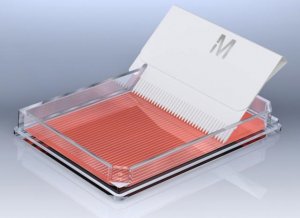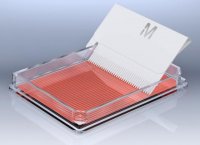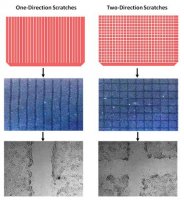- Производитель:
- Sigma-Aldrich
| eCl@ss: | 32161000 |
Click Here!
Cell migration can be studied by a variety of methods, but the scratch assay remains a highly popular method due to the simplicity of the required materials, experimental setup, data collection and interpretation (Lian, C., et al., 2007; Cory, G., 2011). The scratch assay is typically initiated by scratching a confluent cell monolayer with a pipette tip to create a narrow wound-like gap. Shortly after wounding, the cells at the edge of the wound initiate a program to migrate into the gap, a process that continues until the gap has been completely repopulated with cells. Extent of wound closure is typically observed through light microscopy and protein expression patterns that occur during the wound healing process can be characterized by immunofluorescence.
Advances in understanding the repair mechanisms of wounded cell monolayers have been facilitated by the development of methods for performing the assay in multiwell plates. Such methods include delivering wounds to existing monolayers in the wells, or occlusion of the center of the well during monolayer formation to create a gap (Yarrow, J.C., et al., 2004; Simpson K.J., et al., 2008; Gough, W., et al., 2011). Each method then involves quantification of the extent of cell migration into the gap.
However, these methods are not optimal for biochemical analysis of the molecular events mediating wound repair. For example, the small scale of a basic pipette tip-derived wound provides insufficient and inadequate material for biochemical analysis. Using the same pipette tip to scratch a cell monolayer in a larger plate is tedious and irreproducible, and the proportion of migrating cells to quiescent cells is low. Several methods have been described to scale up the scratch assay by creating multiple wounds in cell monolayers but these methods require specialized tools (Turchi, L., et al., 2002; Lauder, H., et al., 1998).
EMD Millipore has developed the Cell Comb™ Scratch Assay to address the need for an easy-to-use tool for creating multiple scratch wounds. The patent pending Cell Comb<TMSYMBOL></TMSYMBOL> has been optimized to apply a high density field of scratches to maximize the area of wound edges, while leaving sufficient numbers of undamaged cells to migrate into the gap. This form of high density wounding creates a high proportion of migrating cells to quiescent monolayer cells, which permits sensitive detection of the biochemical events occurring, specifically in the migrating cell population.
Cell Structure
EMD Millipores patent pending Cell Comb™ Scratch Assay addresses the need for an easy-to-use tool for creating multiple scratch wounds, The Cell Comb has been optimized to apply a high density field of scratches to maximize the area of wound edges, while leaving sufficient numbers of undamaged cells to migrate into the gap. This form of high density wounding creates a high proportion of migrating cells to quiescent monolayer cells, which permits sensitive detection of the biochemical events occurring, specifically in the migrating cell population.
This Cell Comb Scratch Assay has been optimized to apply a high density field of scratches to maximize the area of wound edges, while leaving sufficient undamaged cells to migrate into the gap.
Rectangular Cell Culture Plates: Quantity of 6 individually packaged, cell culture-treated 86 mm x 128 mm plates.
The Cell Combs and Cell Culture Plates have been subjected to E-beam irradiation in order to minimize the possibility of contamination.
CHEMICON is a registered trademark of Merck KGaA, Darmstadt, Germany
| Торговая марка | Cell Comb™, Chemicon®, QCM |
| Quality Level | 100 |
| application(s) | activity assay: suitable, cell analysis: suitable (cell based assays - invasion/migration), sample preparation: suitable (mass spectrometry), western blot: suitable |
| shipped in | ambient |
Получите коммерческое предложение в течение 1 часа
Менеджер подготовит коммерческое предложение и позвонит, если понадобится уточнить детали вашего заказа

С 2010 года мы поставляем оборудование с заводов Европы. Берем на себя все — от подбора оборудования до внедрения на предприятии

Все сотрудники имеют высшее образование, закончили ведущие химические вузы страны, такие как РХТУ им Менделеева.

У большинства компаний срок ожидания составляет 10-12 недель.

Оборудование хранится на сухом отапливаемом складе, где поддерживается ровная температура.

Работаем с PonyExpress и Деловыми линиями. Вы также можете выбрать свою транспортную компанию или забрать товар со склада в Москве.

В случае любых неполадок за свой счет выполним ремонт в сервисном центре или на заводе-изготовителе. Или бесплатно заменим прибор на новый.

Производим пуско-наладку оборудования, валидацию, обучение сотрудников. Если нужно, привлекаем инженеров с заводов- изготовителей.














































































































































